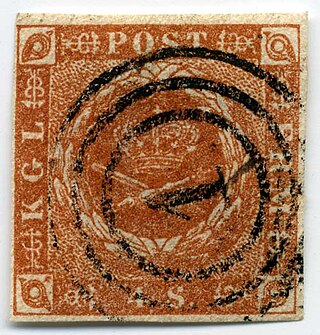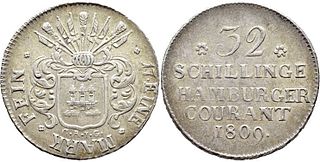| |||||
| Decades: | |||||
|---|---|---|---|---|---|
| See also: | Other events of 1713 List of years in Denmark | ||||
Events from the year 1713 in Denmark .
| |||||
| Decades: | |||||
|---|---|---|---|---|---|
| See also: | Other events of 1713 List of years in Denmark | ||||
Events from the year 1713 in Denmark .



The svenska riksdaler was the name of a Swedish coin first minted in 1604. Between 1777 and 1873, it was the currency of Sweden. The daler, like the dollar, was named after the German Thaler. The similarly named Reichsthaler, rijksdaalder, and rigsdaler were used in Germany and Austria-Hungary, the Netherlands, and Denmark-Norway, respectively. Riksdaler is still used as a colloquial term for krona, Sweden's modern-day currency.

Frederick IV was King of Denmark and Norway from 1699 until his death. Frederick was the son of Christian V of Denmark-Norway and his wife Charlotte Amalie of Hesse-Kassel.

The krone is the official currency of Denmark, Greenland, and the Faroe Islands, introduced on 1 January 1875. Both the ISO code "DKK" and currency sign "kr." are in common use; the former precedes the value, the latter in some contexts follows it. The currency is sometimes referred to as the Danish crown in English, since krone literally means crown. Krone coins have been minted in Denmark since the 17th century.

The Scandinavian Monetary Union was a monetary union formed by Denmark and Sweden on 5 May 1873, with Norway joining in 1875. It established a common currency unit, the krone/krona, based on the gold standard. It was one of the few tangible results of the Scandinavian political movement of the 19th century. The union ended during World War I.

This is an overview of the postage stamps and postal history of Denmark.

The Reichsthaler, or more specifically the Reichsthaler specie, was a standard thaler silver coin introduced by the Holy Roman Empire in 1566 for use in all German states, minted in various versions for the next 300 years, and containing 25–26 grams fine silver.

The rigsdaler was the name of several currencies used in Denmark until 1875. The similarly named Reichsthaler, riksdaler and rijksdaalder were used in Germany and Austria-Hungary, Sweden and the Netherlands, respectively. These currencies were often anglicized as rix-dollar or rixdollar.
The skilling was the Scandinavian equivalent of the shilling. It was used as a subdivision of the various kinds of currencies named rigsdaler in use throughout Scandinavia, including the Danish rigsdaler, the Norwegian rigsdaler, and the Swedish riksdaler.

The Hamburg Mark refers to two distinct currencies issued in the city of Hamburg until 1875:
The rigsdaler was the currency of the Danish West Indies until 1849. It was subdivided into 96 skilling. The rigsdaler was equal to 4⁄5 Danish rigsdaler. The rigsdaler was replaced by the daler.

Sophie of Mecklenburg-Güstrow was Queen of Denmark and Norway by marriage to Frederick II of Denmark. She was the mother of King Christian IV of Denmark and Anne of Denmark. She was Regent of Schleswig-Holstein from 1590 to 1594.
The Speciethaler was the currency of Schleswig-Holstein until 1866, located in the border region of present-day Denmark and Germany.

The rigsdaler specie was a unit of silver currency used in Norway from 1544, renamed as the speciedaler in 1816 and used until 1873. Norway used a common reichsthaler currency system shared with Denmark, Hamburg and Schleswig-Holstein until 1873 when the gold standard was implemented in Scandinavia and the German Empire.

The rigsdaler was the currency of Greenland until 1874. It was equal to the Danish rigsdaler which circulated in Greenland alongside distinct banknotes from 1803.

The Greenlandic krone was a planned currency for Greenland, plans of which were abandoned in 2009. The same name is often used for currency issued during Greenland's time as a Danish colony. The name krone is derived from the Danish krone, introduced in an 1873 currency reform that replaced Danish mark and skilling.
Events from the year 1849 in Denmark.
Events from the year 1769 in Denmark.
Events from the year 1774 in Denmark.

Frederiksberg Church is the oldest church building in the Frederiksberg district of Copenhagen, Denmark. Completed in 1734, it is built to an unusual octagonal design in Baroque style. It is situated at Frederiksberg Runddel in front of the main entrance to Frederiksberg Gardens, on the corner of Frederiksberg Allé and Pile Allé,

HDMS Fridericus Quartus, launched at Royal Danish Naval Dockyards in 1699, was a three-deck, 110-gun ship of the line designed to be the flagship of the Royal Dano-Norwegian Navy. She soon proved difficult to navigate, and unsuited for the shallow Danish waters. She was later used as an East Indiaman, first by the Danish East India Company and then by the Danish Asiatic Company. She was wrecked at Skagen in November 1736, shortly after embarking on her second DAC expedition to Tranquebar. She co-existed with another ship by the same name, a slave ship owned by the Danish West India Company, which wrecked off Costa Rica's coast in 1710.